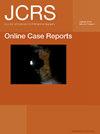Anterior segment OCT findings and atypical refractive changes secondary to Epstein-Barr virus–associated nummular keratitis
Q4 Medicine
引用次数: 0
Abstract
Introduction: This case study described refractive changes that can occur in the setting of Epstein-Barr virus (EBV)-associated nummular keratitis (NK) and highlighted the role that anterior segment optical coherence tomography can serve in diagnosis and management of this disease. Patient and Clinical Findings: A 15-year-old girl developed subepithelial and anterior stromal corneal lesions and experienced progressive decline in the corrected distance visual acuity. She also developed a significant myopic shift with increased keratometric and refractive astigmatism. Diagnosis, Intervention, and Outcomes Targeted laboratory testing was performed. A diagnosis of chronic EBV-associated NK was made, and the patient was treated with systemic valacyclovir and topical steroids. Clinical appearance of lesions and corrected distance visual acuity improved, although refractive and keratometric changes persisted. Conclusions: Significant and persistent refractive changes can occur in the setting of EBV-associated NK, similar to those seen after conductive keratoplasty. Anterior segment optical coherence tomography can be a potentially helpful supplementary diagnostic imaging modality to avoid invasive testing in such cases.Epstein-Barr病毒相关性努穆拉角膜炎继发的前段OCT表现和非典型屈光变化
引言:本病例研究描述了在EB病毒相关的努穆拉角膜炎(NK)的情况下可能发生的屈光变化,并强调了前段光学相干断层扫描在诊断和治疗该疾病中的作用。患者和临床发现:一名15岁女孩出现上皮下和前基质角膜病变,矫正远视敏度逐渐下降。她还出现了明显的近视转移,角膜屈光度和屈光性散光增加。诊断、干预和结果进行了有针对性的实验室测试。诊断为慢性EB病毒相关的NK,并对患者进行了全身伐昔洛韦和局部类固醇治疗。病变的临床表现和矫正的远视敏度有所改善,尽管屈光度和角膜曲率的变化仍然存在。结论:在EBV相关的NK环境中,可以发生显著和持久的屈光变化,类似于传导性角膜移植术后的屈光变化。在这种情况下,前段光学相干断层扫描可能是一种潜在的有用的辅助诊断成像方式,以避免侵入性测试。
本文章由计算机程序翻译,如有差异,请以英文原文为准。
求助全文
约1分钟内获得全文
求助全文

 求助内容:
求助内容: 应助结果提醒方式:
应助结果提醒方式:


